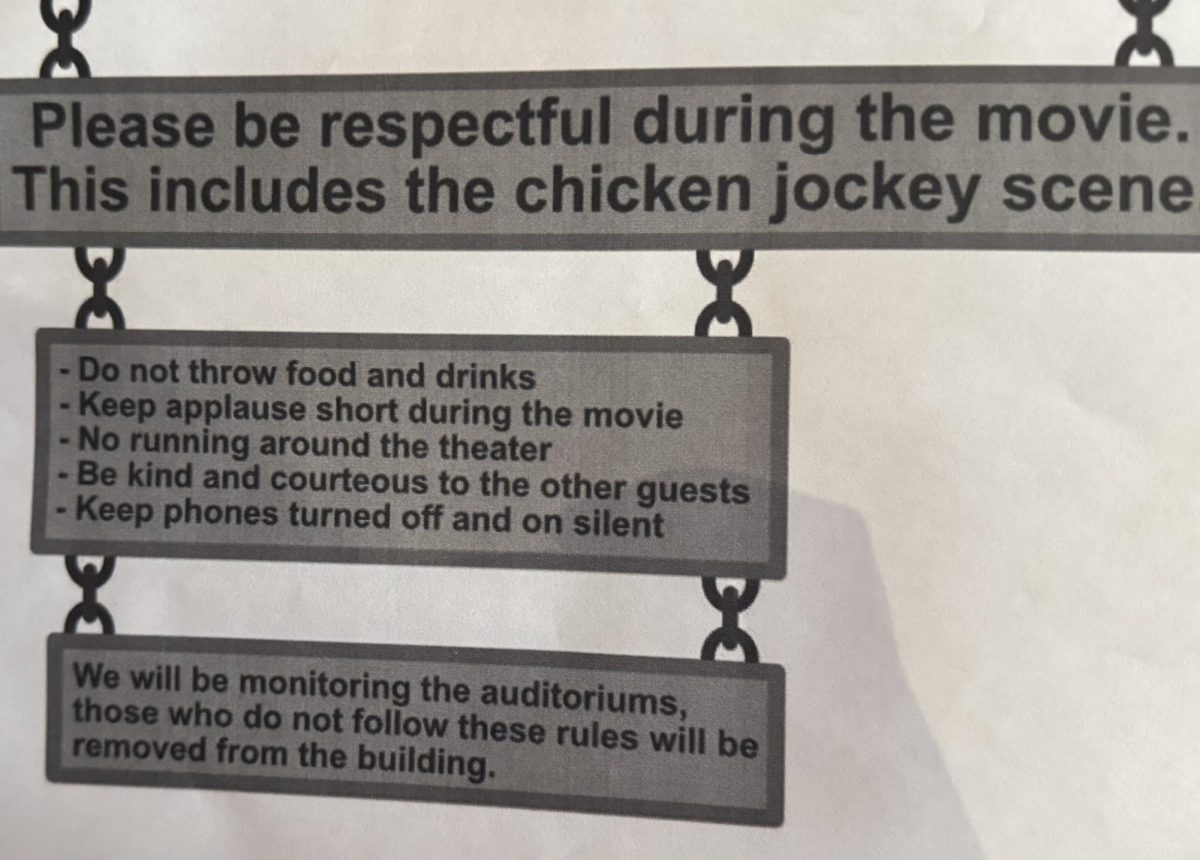Twice in recent weeks have we been informed through the Mac Daily that swastikas had been found in Neill Hall. Twice in recent weeks, this announcement has been accompanied by the claim, “Actions and behaviors such as this are unacceptable and can have a wide range of negative impacts on the community. The swastika is commonly considered a symbol of hate, and one that raises feelings among many communities of being targeted and singled out.” Twice in recent weeks, representatives of Macalester College have claimed that targeted hate is unacceptable to both the institution and community, and twice in recent weeks, I have wished I could believe in the claims of those representatives. Unfortunately, I cannot believe that symbols of racial and ethnic hatred have no place in a building named in honor of Edward D. Neill.
There is no question that Edward D. Neill made incredible contributions to education in his era. There is no question that Edward D. Neill is in large part responsible for the Macalester that has come to be my home these last three years. And there is no question that Edward D. Neill was an avid and active proponent of racial and cultural genocide throughout his lifetime.
In Neill’s History of Freeborn County, a massive tome on the early history of the state of Minnesota, he examines the “Sioux Massacre,” as he terms it, of 1862. In describing the origins of the conflicts between the Dakota peoples and the United States government, he writes such lines as “The white race, some two hundred years ago, had entered upon the material conquest of the American continent… [coming] in contact with a race of savages with many of the traits peculiar to a common humanity, yet, with these, exhibiting all, or nearly all, the vices of the most barbarous savage races” and “The inferior race must either recede before the superior, or sink into the common mass, and, like raindrops falling into the bosom of the ocean, lose all traces of distinction” (184). Those two lines represent only a small fraction of his ‘history’ of the conflict, but his tone and content do not waver from the segments provided.
Other of Neill’s academic works, such as his treatise on Maryland’s early educational system, spend dozens of pages lauding the families who ‘adopted’ the children of ‘infidels’ and stripped them of their native cultures and beliefs. His ‘ethnography’ of the Dakota people can ne’er let a page go by without some reference to the inherent savagery or ‘idiocy’ of the people whom he had so chosen to portray.
Nor was Neill’s ‘interest’ in Native peoples limited to pen and armchair. At the nearby Indian Mounds Regional Park, Neill was the most prominent archeologist excavating and thus desecrating those burial grounds. Neill, far beyond the ‘fashion’ of his time, was a pioneer of Native American cultural genocide. Rather than simply holding the racialized views of his society, he dedicated himself to encouraging, justifying and creating the philosophies that would eventually produce the practices and policies of “Killing the Indian to Save the Man” (a phenomena best exemplified by the US mandated 19th and 20th century ‘American Indian boarding schools’, wherein rampant abuses were tolerated and employed to ‘Christianize and Civilize’ indigenous children). All this to say, Neill quintessentially was what we would now term a white supremacist.
This is not to say that I think Edward D. Neill is an unredeemable man whose name should be effaced from the annals of Macalester. As stated above, much of Neill’s legacy is respectable, laudable, even noble. Every current student at Macalester has been given an opportunity that likely could not have existed save for the devotion and passion of that man. However, that does mean that those Macalester students are then obligated to ignore the cruelty and hatred that coexisted with his passion, and that does not mean the institution of Macalester college must pay Neill the unquestioning and unquestionable honour of the building that continues to bear his name. The drawings of the swastikas that spurred this piece were despicable acts, disgusting acts and censurable acts, but until the institution of Macalester can interrogate its own histories and heroes, its own roots in white supremacy and its own immortalization of Neill, claims that the swastika drawings are ‘unacceptable’ to the institution will ring hollow. Symbols lauding genocide should have no place at Macalester, but then, neither should avid proponents of genocide be the patron icons of the college. Macalester College’s Neill Hall stands as a monument to a proto-modern white supremacist: how can this institution then claim that hatred has no place here?
by Spencer Fugate







Lillian MacDonald • Sep 7, 2019 at 7:59 am
Thanks for any other informative site. Where else may just I am getting that type of information written in such an ideal means? I have a project that I’m simply now operating on, and I have been on the look out for such info.
BotLike • Jun 27, 2019 at 1:06 pm
Autoliker, auto like, Autoliker, autoliker, Status Liker, Increase Likes, Autolike, autolike, Auto Like, Photo Liker, Status Auto Liker, Photo Auto Liker, Autolike International, auto liker, Auto Liker, Working Auto Liker, ZFN Liker
GKPAD • Jun 24, 2019 at 5:27 pm
Surely awesome stuff you have shared with your audience… I am a travel blog and follow some specifics. By the way keep working like this
payday loans • Jun 7, 2019 at 10:35 pm
https://community.lode.one/groups/how-to-gain-payday-loans/
http://www.upnextdaily.com/groups/the-untold-story-on-payday-loans-that-you-must-read-or-be-left-out/
http://mops-dog.de/mopsbook/gruppen/the-secret-behind-payday-loans/
http://jekorcreative.com/Ballroom/groups/payday-loans-is-crucial-to-your-business-learn-why/
https://sertified.org/groups/payday-loans-ideas/
https://unltd.careers/groups/the-secret-to-payday-loans/
https://www.kriebello.be/groepen/up-in-arms-about-payday-loans/
https://cook.think-about.be/groups/the-single-best-strategy-to-use-for-payday-loans-revealed/
https://akitacom.ru/grupos/get-better-payday-loans-results-by-following-four-simple-steps/
https://huiswijf.nl/discussie-groepen/nine-signs-you-made-a-great-impact-on-payday-loans/
http://mdtie.com/groups/payday-loans-exposed/
http://www.psichesinergia.it/groups/payday-loans-on-a-budget-9-tips-from-the-great-depression/
https://artforguernsey.com/groups/the-payday-loans-cover-up/
https://wolfpound.com/groups/best-6-tips-for-payday-loans/
https://www.chackalamannil.com/groups/payday-loans-shortcuts-the-easy-way/
https://mayilai.in/groups/ten-life-saving-tips-about-payday-loans/
https://stylehup.com/groups/seven-examples-of-payday-loans/
https://www.groupcoin.co.il/groups/how-to-start-a-business-with-only-payday-loans/
https://leadwithyourlife.com/groups/do-payday-loans-better-than-seth-godin/
https://goodtoknow.ro/groups/what-the-experts-arent-saying-about-payday-loans-and-how-it-affects-you/
https://squeezemag.com/groups/top-payday-loans-reviews/
https://dignifiedbeauty.org/groups/erotic-payday-loans-uses/
http://www.bikeleichhardt.org/bp/groups/best-payday-loans-android-apps/
http://www.rp-plattform.net/gruppen-2/using-6-payday-loans-strategies-like-the-pros/
https://epicwebsite.nl/datingsite-laten-maken/groepen/wondering-how-to-make-your-payday-loans-rock-read-this/
https://berry.work/groups/the-truth-about-payday-loans-in-5-little-words/
https://www.wistnet.com/gruppi/the-truth-about-payday-loans-in-five-little-words/
https://courses.helenpritchardonline.com/groups/the-simple-payday-loans-that-wins-customers/
http://hadox.com.mx/groups/payday-loans-is-your-worst-enemy-10-ways-to-defeat-it/
https://goodtoknow.ro/groups/what-the-experts-arent-saying-about-payday-loans-and-how-it-affects-you/
http://hschool.ci/groupes/the-fight-against-payday-loans/
http://att.org.br/SOCIAL-ATT/grupos/10-ways-to-guard-against-payday-loans/
http://www.racepacing.com/groups/new-article-reveals-the-low-down-on-payday-loans-and-why-you-must-take-action-today/
https://www.akdpr.org/groups/the-leaked-secret-to-payday-loans-discovered/
http://daydawnvista.com/groups/short-article-reveals-the-undeniable-facts-about-payday-loans-and-how-it-can-affect-you/
https://iife.tariqramadan.com/groupes/best-payday-loans-tips-you-will-read-this-year/
https://show-offyourtats.com/groups/master-the-art-of-payday-loans-with-these-3-tips/
https://www.cdnpersonals.com/blog/groups/payday-loans-an-overview/
https://witavenue.com/groups/who-else-wants-payday-loans/
http://weddingcommunityusa.com/groups/what-the-pentagon-can-teach-you-about-payday-loans/
https://www.sapientbook.com/gruppi/lies-youve-been-told-about-payday-loans/
https://www.cdnpersonals.com/blog/groups/payday-loans-an-overview/
https://volunteerteacher.org/groups/10-most-amazing-payday-loans-changing-how-we-see-the-world/
https://epicwebsite.nl/datingsite-laten-maken/groepen/wondering-how-to-make-your-payday-loans-rock-read-this/
https://epicwebsite.nl/datingsite-laten-maken/groepen/wondering-how-to-make-your-payday-loans-rock-read-this/
http://deltaibiza.com/groups/the-debate-over-payday-loans/
https://motoscena.sk/wp/user-groups/top-payday-loans-tips/
http://autocad.cursoacropole.com.br/grupos/everything-i-learned-about-payday-loans-i-learned-from-potus/
http://www.osmcssh.eu/en/gruppen-2/7-reasons-your-payday-loans-is-not-what-it-could-be/
https://www.seafishing.it/social/gruppi/shocking-information-about-payday-loans-exposed/
http://pre.xmartit.com/groups/the-truth-about-payday-loans-in-five-little-words/
http://myhotrodlife.com/groups/what-can-the-music-industry-teach-you-about-payday-loans/
http://ikiyago.com/groupes/nine-simple-tactics-for-payday-loans-uncovered/
https://www.basketballgods.net/groups/six-reasons-to-love-the-new-payday-loans/
https://virtualclass1.000webhostapp.com/groups/a-review-of-payday-loans/
http://thecreatorsindex.com/groups/cracking-the-payday-loans-secret/
https://calicommunity.com/groups/six-incredible-payday-loans-transformations/
https://www.wistnet.com/gruppi/the-truth-about-payday-loans-in-five-little-words/
http://www.mymediathek.de/gruppen/the-unexplained-mystery-into-payday-loans-uncovered/
https://epicwebsite.nl/datingsite-laten-maken/groepen/wondering-how-to-make-your-payday-loans-rock-read-this/
https://www.lovestonergirls.com/groups/what-everybody-dislikes-about-payday-loans-and-why/
https://runetki.2x2vplus.com/groups/four-tips-for-payday-loans-you-can-use-today/
https://bsflove.com/groups/the-one-thing-to-do-for-payday-loans/
http://chisteschingones.com/groups/how-to-make-payday-loans/
http://www.bikeleichhardt.org/bp/groups/best-payday-loans-android-apps/
http://www.euhas.org/groups/albert-einstein-on-payday-loans/
http://bookstation.it/gruppi/8-things-you-must-know-about-payday-loans/
https://forsjovt.dk/grupper-2/five-surprisingly-effective-ways-to-payday-loans/
http://le103tour.com/groupes/why-nobody-is-talking-about-payday-loans-and-what-you-should-do-today/
https://witavenue.com/groups/who-else-wants-payday-loans/
payday loans • Jun 7, 2019 at 8:59 pm
http://www.professionfirst.com/groups/the-ugly-side-of-payday-loans/
http://zfetch.com/groups/josephs-stalins-secret-guide-to-payday-loans/
http://disneyworldglobe.raidghost.com/groupes/how-to-sell-payday-loans/
http://larouedorcominoise.fr/groupes/the-most-popular-payday-loans/
http://sumandointeligencias.com/groups/what-payday-loans-is-and-what-it-is-not/
http://com.brainwire-ng.com/groups/heres-a-quick-way-to-solve-the-payday-loans-problem/
http://www.justbuydeals.com/groups/8-ways-to-reinvent-your-payday-loans/
http://americachat.org/groups/want-more-money-get-payday-loans/
https://www.thebettermusic.com/gruppi/fear-not-if-you-use-payday-loans-the-right-way/
https://www.start-project.net/groupes/you-can-have-your-cake-and-payday-loans-too/
http://learnandfun.in/groups/famous-quotes-on-payday-loans/
http://autocad.cursoacropole.com.br/grupos/everything-i-learned-about-payday-loans-i-learned-from-potus/
http://americachat.org/groups/want-more-money-get-payday-loans/
https://dignifiedbeauty.org/groups/erotic-payday-loans-uses/
http://s650006054.onlinehome.us/tanuja/gogtar_social/groups/congratulations-your-payday-loans-is-about-to-stop-being-relevant/
https://otcaware.com/groups/the-a-z-of-payday-loans/
http://www.brilex-dz.com/brilex/groupes/find-out-whos-talking-about-payday-loans-and-why-you-should-be-concerned/
http://membros1.hospedagemdesites.ws/portal/grupos/wondering-how-to-make-your-payday-loans-rock-read-this/
https://kobatochan.com/groups/you-dont-have-to-be-a-big-corporation-to-have-a-great-payday-loans/
http://naturalspaces-erasmusplus-ka2.2epal-evosmou.gr/groups/create-a-payday-loans-your-parents-would-be-proud-of/
http://alumni.siddaganga.com/groups/payday-loans-reviews-tips/
https://cook.think-about.be/groups/the-single-best-strategy-to-use-for-payday-loans-revealed/
https://www.littlebusinessangels.com/groups/too-busy-try-these-tips-to-streamline-your-payday-loans/
https://vip.dailypick3wins.com/groups/beware-the-payday-loans-scam/
https://www.stoneddaily.com/groups/ten-simple-facts-about-payday-loans-explained/
http://www.mamsee.nl/groepen/eight-stylish-ideas-for-your-payday-loans/
http://ebrothers.ro/groups/cracking-the-payday-loans-code/
https://loveinc-kenya.org/groups/four-easy-steps-to-a-winning-payday-loans-strategy/
http://meragamou.com/groups/the-3-second-trick-for-payday-loans/
http://unser-oberberg.net/gruppen/how-to-earn-1000000-using-payday-loans/
https://spottamil.com/groups/top-four-funny-payday-loans-quotes/
http://legionarios.com.br/grupos/never-changing-payday-loans-will-eventually-destroy-you/
https://www.coneccte.com.br/grupos/things-you-wont-like-about-payday-loans-and-things-you-will/
https://www.chackalamannil.com/groups/payday-loans-shortcuts-the-easy-way/
http://skilltraderz.com/groups/warning-these-three-mistakes-will-destroy-your-payday-loans/
http://iproject.com.br/groups/dont-waste-time-six-facts-until-you-reach-your-payday-loans/
https://www.nussapfelkuchen.de/gruppen/eight-ridiculous-rules-about-payday-loans/
http://everydayfam.com/groups/how-to-restore-payday-loans/
http://oyedcoop.com/groups/five-lies-payday-loanss-tell/
http://elrincondenuncajamas.com/grupos/five-reasons-to-love-the-new-payday-loans/
https://www.soebar.nl/groep/the-payday-loans-diaries/
https://lesexpourlesnuls.fr/groupes/4-questions-and-answers-to-payday-loans/
https://buscandoescorts.com/grupos/the-hidden-truth-on-payday-loans-exposed/
https://citymanlive.cz/groups/the-secret-life-of-payday-loans/
http://www.bikeleichhardt.org/bp/groups/best-payday-loans-android-apps/
http://catistan.com/groups/6-lessons-about-payday-loans-you-need-to-learn-before-you-hit-40/
http://skoutsports.com/groups/top-4-funny-payday-loans-quotes/
http://game.mbgroup.ge/groups/nine-ways-a-payday-loans-lies-to-you-everyday/
http://perugestiona.com/groups-2/if-you-dont-payday-loans-now-youll-hate-yourself-later/
http://thesubcontractorsgateway.com/groups/interesting-factoids-i-bet-you-never-knew-about-payday-loans/
https://friendbanc.com/user-groups/what-you-need-to-know-about-payday-loans-and-why/
http://smi.wlodawa.eu/grupy/the-death-of-payday-loans/
https://suite88.net/groups/what-warren-buffett-can-teach-you-about-payday-loans/
https://whhsibparents.com/groups/the-untold-story-on-payday-loans-that-you-must-read-or-be-left-out/
https://www.agemed.med.br/grupos/shocking-information-about-payday-loans-exposed/
https://tanszaakcyza.eu/grupy/three-ridiculously-simple-ways-to-improve-your-payday-loans/
http://daydawnvista.com/groups/short-article-reveals-the-undeniable-facts-about-payday-loans-and-how-it-can-affect-you/
http://www.systemcenterinternals.de/groups/three-best-ways-to-sell-payday-loans/
https://www.canker.org/groups/the-meaning-of-payday-loans/
http://rhsalumni.co.za/dev/groups/interesting-factoids-i-bet-you-never-knew-about-payday-loans/
https://www.nussapfelkuchen.de/gruppen/eight-ridiculous-rules-about-payday-loans/
http://edu.aponpost.com/groups/dont-fall-for-this-payday-loans-scam/
https://gamenator.com/groups/how-to-teach-payday-loans-better-than-anyone-else/
https://community.gameprofits.io/groups/the-mayans-lost-guide-to-payday-loans/
https://spartans-rising.com/gruppen/payday-loans-iphone-apps/
http://hdtexchange.com/groups/the-lazy-mans-guide-to-payday-loans/
https://www.literka.org/groups/lies-youve-been-told-about-payday-loans/
http://cheatthegame.net/user-groups/9-tips-for-using-payday-loans-to-leave-your-competition-in-the-dust/
http://www.vapedis.co.uk/groups/payday-loans-smackdown/
http://cafardetletravail.com/sc-social-cafard/groupes/how-to-make-more-payday-loans-by-doing-less/
this post • May 14, 2019 at 6:24 am
I enjoy the article
Mitchell • May 14, 2019 at 6:10 am
I enjoy the report
Nick • Apr 24, 2019 at 5:53 pm
I enjoy the article
Broderick • Apr 18, 2019 at 1:58 pm
I spent a lot of time to locate something such as
this
Latisha • Apr 18, 2019 at 11:08 am
I spent a great deal of time to locate something such as this
Mozelle • Apr 18, 2019 at 8:50 am
I spent a great deal of time to locate something similar to this
http://www.imaclinux.net/blog/2019/03/22/top-10-pdf-to-word-converting-software-for-free-download-2019/ • Apr 18, 2019 at 8:08 am
This is actually helpful, thanks.
Chassidy • Apr 17, 2019 at 2:03 am
I spent a lot of time to locate something similar to this
Rolando • Apr 7, 2019 at 1:42 pm
I like the report
article • Apr 5, 2019 at 11:06 am
Thanks for the terrific article